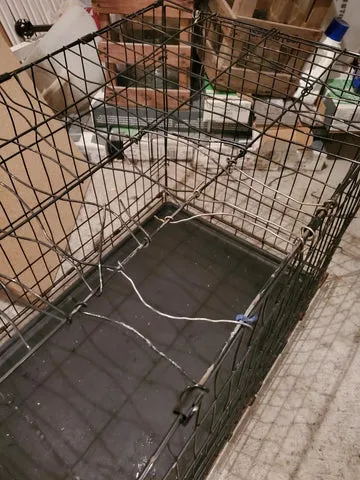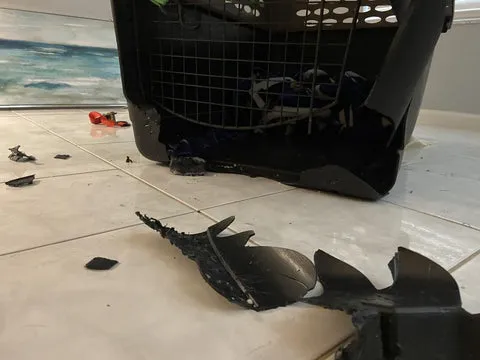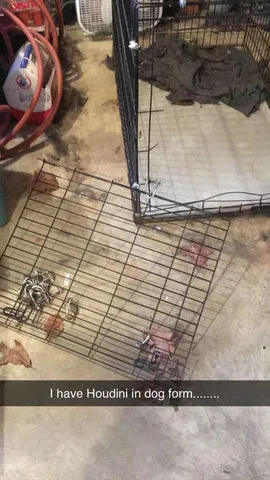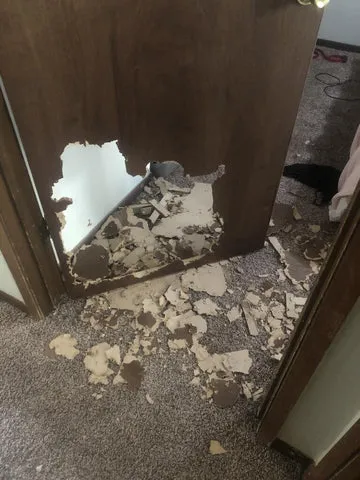Discovering that your dog has escaped their crate can be a jarring experience, often leading to damaged household items, potential injury to your beloved pet, and immense stress for you. If you frequently find yourself asking, “Why does my dog escape her crate?” or searching for solutions to prevent these ingenious breakouts, you’re not alone. Many dog owners face this challenge, especially when relying on standard wire or thin plastic crates that are not designed for determined or anxious canines. The reality is, a truly indestructible, escape-proof crate made from high-quality materials won’t be found among the cheapest options on the market. Expecting an inexpensive crate to withstand the relentless efforts of an anxious or high-drive dog is often an exercise in futility, similar to expecting a budget car to perform like a luxury vehicle. Understanding the underlying reasons for your dog’s escape attempts and investing in the right equipment are crucial steps toward ensuring their safety and your peace of mind.
When it comes to providing a secure and safe environment for your canine companion, the adage “you get what you pay for” often holds true, especially with dog crates. While a basic crate might suffice for a calm, well-adjusted dog, it can become a significant hazard for a dog prone to escapes. The goal is to find a crate that not only contains your dog but also protects them from self-harm and reduces their anxiety. This guide will delve into why dogs escape, the dangers of inadequate crates, and what features to look for in a truly escape-proof solution, offering valuable insights for every dog owner struggling with a canine Houdini.
Crate Responsibly: Ensuring Your Dog’s Well-being
The primary purpose of any dog crate should be to ensure your pet’s safety and well-being. This isn’t just about containment; it’s about providing a secure, comfortable space that your dog associates positively with rest and security. Not every dog requires an escape-proof crate, and for many, a standard wire crate works perfectly well. However, if your dog consistently breaks out, damages the crate, or shows signs of extreme distress, it’s time to re-evaluate their current setup.
Choosing the right dog crate involves considering several factors: it should fit your dog’s size appropriately, be suitable for its intended use (e.g., car travel, home use, dog shows), and, most importantly, be safe enough for your dog’s specific temperament. Proper crate training from puppyhood is foundational. It helps establish a positive association with the crate, transforming it into a personal sanctuary rather than a place of punishment. Engaging a professional dog trainer or researching effective crate training methods can make a significant difference in how your dog perceives their enclosed space. For instance, understanding potty training a 12 week old puppy often involves positive crate association, which is vital for long-term comfort.
It is imperative never to use a crate as a form of punishment. Doing so can quickly erode any positive associations your dog has developed, leading to increased anxiety and a greater desire to escape. Furthermore, dogs should not be kept in crates for excessively long periods. A crate is a tool for safety and management, not a permanent living space. If your dog has a history of destroying crates, upgrading to a heavy-duty, escape-proof model is a responsible choice to prevent injury. If you notice bent wires, zip-ties holding a crate together, or any compromised structural integrity, discontinue use immediately. A damaged crate is a dangerous crate. An escape-proof dog crate acts as a protective tool for pets with separation anxiety, but it is not a standalone solution. Addressing the root cause of anxiety through consistent training and behavior modification is key.
 Dog chewed through wire kennel wires, exposing holes and creating a dangerous escape route.
Dog chewed through wire kennel wires, exposing holes and creating a dangerous escape route.
Understanding Why My Dog Escapes Her Crate
The question “Why does my dog escape her crate?” delves into complex canine behavior. While some dogs are content in minimalist crates, others become frantic when confined. Several factors contribute to a dog’s desperate attempts to break free, often rooted in various forms of anxiety or specific behavioral traits.
Many dogs who escape their crates suffer from anxiety triggered by confinement or separation from their owners. Common stressors include separation anxiety, Post-Traumatic Stress Disorder (PTSD), storm phobia, or past abuse from previous owners. Rescue dogs, in particular, may carry trauma from being abandoned for extended periods in kennels without breaks, food, or exercise. For these dogs, a crate can become a painful reminder of past neglect, leading to extreme separation anxiety and a profound urge to escape. It’s a heartbreaking reality that many pups will risk self-injury to be reunited with their families or simply to be out of their perceived prison.
Inadequate or inconsistent crate training can also be a significant contributor. A dog might have been crate-trained as a puppy but then rarely used the crate for years. When suddenly reintroduced to a kennel due to a vet recommendation or a new situation, they are expected to be content without proper re-acclimation. This abrupt change can trigger anxious crate behavior, making them feel uneasy and prompting escape attempts. Just as we might train a dog not to bark incessantly by understanding how to stop a dog from barking in the house, addressing crate escape behavior requires understanding its triggers and providing appropriate training.
 Plastic pet carrier broken by a dog, with plastic shards scattered on the floor, posing a risk of injury.
Plastic pet carrier broken by a dog, with plastic shards scattered on the floor, posing a risk of injury.
A dog’s temperament also plays a crucial role. High-drive breeds such as Belgian Malinois, German Shepherds, Border Collies, and Siberian Huskies often possess a natural intelligence and determination that sees a crate as a challenge to be conquered. These dogs are natural problem-solvers and can quickly learn to outsmart even seemingly secure enclosures. When a dog successfully escapes a crate—whether by chewing through plastic, bending wires, or manipulating a latch—they perceive this newfound freedom as a reward. This “victory” reinforces the behavior, turning every subsequent crate into a “challenge accepted.”
The Cost of Inadequate Crates: More Than Just Money
Many dog owners, grappling with a “Houdini dog,” fall into a common trap: replacing a mangled wire crate with another similar, flimsy model. This repetitive cycle, expecting different results from the same approach, is often described as insanity. Unfortunately, the consequences extend far beyond the cost of a new crate. The reviews and testimonials from countless dog owners highlight the shocking financial and emotional toll of inadequate crates.
The expenses can quickly accumulate, including:
- Home Repairs: Replacing chewed flooring, carpets, blinds, drywall, molding, doors, and fences. One owner reported their pit/lab mix tearing through several walls in their home after escaping a wire crate.
- Preventing Further Damage: Installing additional locks, extending fences, or setting up surveillance cameras.
- Repeated Crate Purchases: Buying multiple crates in an attempt to find one that works, only to have them destroyed.
- Reinforcing Broken Kennels: Using zip-ties or other makeshift repairs, which compromise safety and are often ineffective.
- Replacing Furniture: Mattresses, couches, pillows, tables, and other household items can become targets for a destructive, unsupervised dog.
- Vet Bills: This is perhaps the most concerning and costly consequence. Emergency surgeries for ingesting toxic household supplies or foreign objects (including pieces of a destroyed crate), stitches for injuries sustained during escape attempts, broken limbs, torn muscles (e.g., from jumping out of a second-story window), and anxiety medication are all potential outcomes. Dogs will often risk severe self-injury in their frantic efforts to escape.
These staggering costs, both financial and emotional, underscore the critical importance of investing in a truly secure and safe crate from the outset. Many owners lament that the cost of a high-quality, escape-proof crate, while initially appearing high, pales in comparison to the cumulative expenses of repeated damage and vet visits.
 A German Shepherd extensively damaged a wire crate, tearing off the front door in an escape attempt.
A German Shepherd extensively damaged a wire crate, tearing off the front door in an escape attempt.
The Purpose of a Wire Crate and Its Limitations
Wire kennels primarily serve as an at-home solution for general puppy training, especially for house-training. They help build a positive foundation, teaching puppies to enjoy alone time for sleeping or as a personal retreat. However, it’s crucial to recognize their significant limitations. Wire crates are generally not recommended for car transport, nor are they airline-approved due to their inherent flimsiness and lack of structural integrity.
Crucially, a basic wire or thin plastic dog crate is not engineered to keep anxious, destructive, or highly motivated dogs safe and secure. Every dog is unique, with differing backgrounds, temperaments, training levels, and sizes. A plastic crate that is perfectly satisfactory for a 20 lb Miniature Schnauzer will likely prove insufficient and unsafe for a determined Plott Hound or a powerful German Shepherd. For dogs that view confinement as a challenge or are overwhelmed by anxiety, wire and flimsy plastic crates can easily become dangerous traps rather than safe havens. If you’re encountering issues with excessive barking, you might find valuable insights on how to stop a dog from barking in the house that could complement crate training.
The inherent design of wire crates with their exposed bars and often weak latches provides multiple points of vulnerability for an escaping dog. These dogs can bend, chew, and manipulate their way through the crate, often sustaining injuries in the process. When My Dog Escapes Her Crate from a wire kennel, it’s a clear signal that the crate is insufficient and a more robust solution is needed to protect both the dog and the home.
Understanding How Your Dog Is Escaping the Crate
Before investing in yet another crate, it’s essential to understand how your dog is managing to escape. Observing their methods can guide you toward a more effective solution and prevent you from repeatedly buying unsuitable crates.
- Chewing and Digging: If your dog uses its canines and claws to dig through plastic or bend wires, then a crate with a solid, chew-proof frame and smooth interior surfaces is a necessary starting point. This prevents them from gaining purchase with their teeth or paws.
- Forcing Doors Open: For large, muscular dogs who ram their bodies against the crate door until it pops open, a heavy-duty kennel with multiple, robust latches and a strong, unyielding door is crucial. This design resists brute force and prevents accidental openings.
- Outsmarting Latches: If your intelligent dog has managed to manipulate or outsmart every latch you’ve “secured,” then an escape-proof crate with no accessible moving parts from the inside and complex, multi-stage latches is key. The more intricate the locking mechanism, the better.
- Exploiting Weak Points: Dogs determined to destroy crates by bending bars, chewing through ventilation holes, or pulling at any component often sustain injuries from sharp edges. For these pups, a secure crate constructed of solid material (that can’t be bent), with smooth walls, small ventilation holes, and no exposed hardware is vital to reduce their chances of injury.
 Husky escaped a wire crate, tearing up carpet and stairs, causing significant home damage.
Husky escaped a wire crate, tearing up carpet and stairs, causing significant home damage.
Assuming your dog is an escape artist, it’s time to critically assess your current crate and ask, “Is this crate truly safe enough for my pup?” Understanding the common methods dogs use to escape kennels, crates, cages, and pet carriers is the first step in preventing further breakouts and ensuring your dog’s safety. For instance, if your dog is prone to puppy pad training vs outside issues, you’d address it differently than an escape artist.
What to Look For in an Escape-Proof Dog Crate
When your dog frequently escapes her crate, it’s clear that a standard solution won’t suffice. An escape-proof dog crate requires specific design features to ensure security and prevent injury. Here are the must-have characteristics for an indestructible, escape-proof crate:
Durable Material Construction
Flimsy wire, thin plastic, fabric, flexible metal, and wood are all chewable materials for destructive dogs. Look for a thick metal crate, ideally with solid sides rather than just bars or wire contraptions. Avoid any ingestible materials or hardware that your dog can reach from inside the crate. This includes crates with exposed bars, as dogs can reach paws or teeth through them to access household objects or the crate latches. For dogs prone to digging and scratching, a thick, durable crate that can withstand their efforts is essential.
Multiple and Complex Latches for Security
Crate latches should be designed to be completely out of your dog’s reach and impossible to manipulate from the inside. Bonus points for crates that include additional latches, such as butterfly latches across the door, providing extra layers of security. The door latch of a truly secure crate should be more complex than a simple sliding lock. Paddle latches or slam latches are not only easy for a human to operate but are also rated to withstand significant force, typically over 300 lbs, making them incredibly difficult for a dog to open.
Single Door Design
While having multiple points of access might seem convenient, for an escape-proof crate, it’s important to reduce the opportunities for a dog to break through. A single-door design minimizes potential weak points compared to double-door crates, which are often more suitable for pet transport in vehicles than for securing an escape-prone dog at home.
No Removable Pieces
Avoid kennels with removable plastic trays when choosing an escape-proof crate. These trays can quickly become another chew toy for a destructive pup, creating both a mess and a potential ingestion hazard.
Welded Construction for Integrity
A high-quality, indestructible metal dog crate should feature welded construction for superior integrity. This prevents gaps between panels that dogs could exploit and ensures the crate holds up under pressure.
Small Ventilation Holes
Good airflow is vital for your dog’s comfort, but the ventilation holes in an escape-proof crate must be small. Smaller holes significantly reduce the chance of your dog breaking teeth or tearing holes through the sides of the crate. The edges of these holes should also be smooth and powder-coated to protect paws and canines.
Appropriately Spaced Door Bars
An escape-proof dog crate should have specially designed door bars. Large gaps on the door or flimsy plastic material can allow your dog to reach the latches or get their jaw caught. Look for bars made of solid (not hollow) material that are carefully spaced to prevent a dog’s mouth from reaching around and accidentally locking their jaw.
Den-like Environment to Reduce Anxiety
A dark, den-like environment can surprisingly reduce anxiety in many dogs. This concept stems from dogs’ ancestral ties to den animals, who sought cozy, protected spaces. When properly crate trained from a young age, a dog can learn to view their crate as a sanctuary—a peaceful “den” where they are safe and undisturbed. The enclosed, non-distracting nature of such a crate can become a secure retreat for anxious pups. Crates with exposed bars or large ventilation holes fail to create this den-like atmosphere, instead resembling a heavy-duty wire crate without the crucial security of solid walls.
 Dog damage including a chewed-through wooden door in a home after escaping a crate.
Dog damage including a chewed-through wooden door in a home after escaping a crate.
No Exposed Hardware Inside the Crate
The interior of an escape-proof and indestructible crate should be smooth and free of hazards. There should be no exposed screws, sharp plastic edges, or pokey wires that a dog could injure themselves on.
Includes a Dog Damage Warranty
A truly confident manufacturer will offer a warranty against dog damage. For example, some high-anxiety crates come with a 10-year Dog Damage Protection Warranty, meaning the company will provide free replacement parts or even a new crate if a dog damages it, compromising its function or safety. This is a significant indicator of the product’s quality and the manufacturer’s trust in their design.
The Best Solution: High Anxiety Impact Dog Crate
For dog owners whose phrase, “my dog escapes her crate,” has become a recurring nightmare, the High Anxiety Impact Dog Crate stands out as a leading solution. This crate is specifically engineered for dogs with escape-artist tendencies and destructive behaviors. With a track record of over 1200 five-star reviews, it’s widely recommended as the safest choice for an escape-proof dog crate, boasting a claim that no pet has ever escaped it.
The High Anxiety Impact Dog Crate incorporates all the essential features for an indestructible and escape-proof design:
- Stainless-Steel Paddle Latch with Four Butterfly Latches: These latches are exclusively accessible from the outside. The paddle latch hardware inside the door is protected by a smooth, welded metal cover, preventing dogs from snagging teeth or manipulating the mechanism. The door’s hinge is securely riveted, with no exposed internal hardware. This design effectively frustrates dogs who try to ram the door open, as it simply does not budge.
- Heavy-Duty American Aluminum Construction: The crate is built from robust American aluminum and finished with a pet-friendly powder-coat. Its interior is welded together to form a solid, escape-proof kennel, riveted to prevent any gaps or movable parts. The solid floor offers a smooth, powder-coated surface that is comfortable and highly resistant to digging and scratching.
- Small Ventilation Holes for a Den-like Environment: While the ventilation holes are small, they provide ample airflow. Engineered for safety and security, these holes are too small for teeth to snag and are smooth and powder-coated to protect paws and canines. This design creates a cozy, den-like environment with solid walls and an enclosed roof, helping anxious pups feel secure and comfortable.
- Appropriately Spaced Door Bars with Optional Door Guard: The door bars are made of solid aluminum, welded to the frame, and carefully spaced to prevent a dog’s mouth from reaching around the bars or accidentally locking their jaw. Each High Anxiety crate includes a free aluminum door guard, which can be optionally installed to cover the bars, providing an additional layer of security for dogs determined to bite them.
- Spring-Loaded Handles: Like all Impact Dog Crate models, this crate features two spring-loaded handles on the roof, offering convenience for maneuvering the crate and securing it in a vehicle with tie-downs.
- Six Size Options: Available in various lengths (30-inch, 34-inch, 40-inch, 40-inch wide + tall, 42-inch, and 48-inch), ensuring a suitable fit for almost any dog.
- 10-Year Dog Damage Warranty: This industry-leading warranty offers peace of mind. If your dog damages a part of the crate, compromising its function or safety, Impact Dog Crates provides free replacement parts or even a new crate within a decade.
Peace of Mind is Priceless
Knowing your dog is safe and secure while you’re away offers invaluable peace of mind. Coming home to an unharmed dog and an intact home is a truly wonderful feeling. This crate provides the ultimate solution for anxious or escape-prone dogs, allowing owners to leave their pets without constant worry.
Customer Testimonials
Many dog owners have shared their experiences, finding the High Anxiety Impact Dog Crate to be the ultimate solution after trying numerous alternatives. For example, Aimee S. shared, “No more escaping! Our German pup Riley has broken through, chewed and/or destroyed 4 different crates. Her high anxiety Impact crate was the solution to her anxiety. Not only can she not break out, but she is calmer in her crate and loves it!” Similarly, @caitdallas recounted, “He has destroyed $500 or more worth of shoes, gotten into food, clothes and destroyed the crate I had for him. He also had permanently scarred his nose and face from trying to escape.” Their Impact crate finally provided relief. Valerie W. stated, “I’ve had it 3 months and it’s been a life saver knowing he can’t hurt himself. After 3 destroyed wire kennels, this is worth it.” These stories reflect a common sentiment: while the initial investment might seem significant, the long-term benefits in safety, reduced damage, and peace of mind are immeasurable.
Conclusion
When my dog escapes her crate, it’s more than just an inconvenience; it’s a clear signal that your current containment method is insufficient and potentially dangerous. The cycle of replacing flimsy crates, enduring property damage, and facing hefty vet bills can be emotionally and financially draining. Understanding the root causes behind your dog’s escape attempts—whether it’s separation anxiety, past trauma, insufficient training, or a high-drive temperament—is the first step toward finding a lasting solution.
Investing in a high-quality, escape-proof dog crate designed with robust materials, secure latches, and a den-like environment is not merely an expense; it’s an investment in your dog’s safety, well-being, and your own peace of mind. Features such as welded construction, small ventilation holes, appropriate door bar spacing, and a comprehensive dog damage warranty are hallmarks of a truly effective crate. By choosing a crate that matches your dog’s needs and complementing it with proper training and anxiety management techniques, you can transform a stressful situation into a secure and comfortable experience for your beloved companion.
